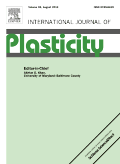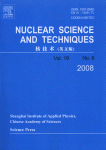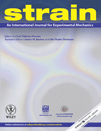
INSTRUMENTS AND EXPERIMENTAL TECHNIQUES
Scope & Guideline
Advancing the Frontiers of Instrumentation and Experimentation
Introduction
Aims and Scopes
- Instrumentation Development:
The journal emphasizes the design and fabrication of novel instruments and devices that can improve measurement accuracy, efficiency, and sensitivity in experimental setups. - Experimental Techniques:
It covers a wide range of experimental methodologies, including but not limited to spectroscopy, imaging, particle detection, and materials characterization. - Interdisciplinary Applications:
The publications reflect a strong interdisciplinary approach, showcasing applications of instrumentation in fields such as nuclear physics, materials science, biophysics, and environmental science. - Innovative Measurement Methods:
The journal highlights new measurement techniques that address specific challenges in scientific research, such as enhancing detection limits or improving temporal and spatial resolution. - Theoretical and Computational Modeling:
Many articles include theoretical frameworks or computational models that support the development and optimization of experimental techniques.
Trending and Emerging
- Advanced Photonic Techniques:
There is an increasing focus on photonic technologies, including laser systems, optical sensors, and fiber-optic methods, which are becoming integral to modern experimental setups. - Nanotechnology and Material Characterization:
Research involving nanostructured materials and their characterization techniques is on the rise, reflecting the growing importance of nanotechnology in various scientific fields. - Machine Learning and Data Analysis:
The application of machine learning algorithms and advanced data analysis techniques in experimental physics is gaining momentum, helping to optimize experiments and analyze complex datasets. - Real-Time Monitoring Systems:
There is a notable trend towards the development of real-time monitoring systems for experiments, allowing for immediate feedback and adjustments during data collection. - Integration of Multi-Modal Techniques:
Emerging research is increasingly integrating multiple techniques (e.g., combining optical, acoustic, and electrical measurements) to provide a more comprehensive understanding of complex systems.
Declining or Waning
- Traditional Photodetection Methods:
Research focused on conventional photodetectors has seen a decline as newer technologies, such as silicon photomultipliers and advanced semiconductor detectors, gain traction. - Basic Scintillation Techniques:
There is a noticeable decrease in publications centered around basic scintillation detection methods, likely due to advancements in more sophisticated and sensitive detection techniques. - Generalized Optical Measurement Techniques:
Publications that employ broad, non-specific optical measurement approaches are becoming less common as the community favors specialized and high-precision methodologies. - Static Measurement Systems:
The focus on static measurement systems, which have traditionally been used in experimental setups, is waning as dynamic and real-time measurement techniques become more relevant. - Historical Instrumentation Reviews:
There has been a decline in articles that review historical instrumentation; instead, the focus has shifted to cutting-edge technologies and future directions.
Similar Journals

EXPERIMENTAL MECHANICS
Pioneering Research in Mechanics of Materials.EXPERIMENTAL MECHANICS, published by SPRINGER, stands at the forefront of research in the fields of Aerospace Engineering, Mechanical Engineering, and Mechanics of Materials. Established in 1961, this esteemed journal has made significant contributions to the understanding and advancement of experimental methodologies and techniques essential for both academic research and practical applications in engineering. With an impressive impact factor and recognition as a Q2 journal in its category for 2023, it ranks 40th in Aerospace Engineering and has established itself as a valuable resource for researchers and practitioners alike. Although it is not an Open Access journal, it provides robust access options, ensuring that high-quality research remains accessible to a broad audience. The journal aims to disseminate innovative findings, foster collaboration, and inspire the next generation of engineers and scientists by focusing on the challenges and developments within experimental mechanics. The editorial board comprises leading experts in their respective fields, further emphasizing the journal’s commitment to excellence and relevance in an ever-evolving technological landscape.

INTERNATIONAL JOURNAL OF PLASTICITY
Charting New Territories in Plasticity ExplorationINTERNATIONAL JOURNAL OF PLASTICITY, published by Pergamon-Elsevier Science Ltd, stands as a pivotal forum in the field of materials science and engineering, exploring the nuances of plastic behavior in materials. With its ISSN 0749-6419 and E-ISSN 1879-2154, this esteemed journal has been a cornerstone of academic research since its inception in 1985, continuing to hold significant relevance as it converges towards 2024. Ranking in the Q1 quartile across multiple categories, including Materials Science (Miscellaneous), Mechanical Engineering, and Mechanics of Materials, it is recognized for its high impact, evidenced by its competitive Scopus rankings that place it in the 97th percentile among mechanical engineering journals. Although it does not offer open access, the journal remains committed to disseminating cutting-edge research findings that advance understanding in plasticity, providing researchers, professionals, and students with vital insights into contemporary issues and innovations in the field.

ACS Measurement Science Au
Connecting Disciplines through Innovative Measurement SolutionsACS Measurement Science Au, published by the American Chemical Society, is a leading open-access journal that has been at the forefront of measurement science since its inception in 2021. With its strong impact and esteemed reputation in the field, the journal has achieved impressive Scopus rankings, including Q1 in Analytical Chemistry and Q2 in Electrochemistry, reflecting its commitment to high-quality research and innovation. As a vital resource for researchers, professionals, and students alike, ACS Measurement Science Au covers a broad scope encompassing advanced measurement techniques across various domains, including spectroscopy and electrochemistry. With its open-access model, the journal ensures that cutting-edge research is readily available to the global scientific community, supporting collaboration and knowledge sharing. By fostering discussions that bridge different disciplines within measurement science, this journal plays a crucial role in advancing the forefront of analytical methods and instrumentation.

MOMENTO-Revista de Fisica
Connecting Scholars to Shape the Future of PhysicsMOMENTO-Revista de Fisica is a distinguished academic journal published by UNIV NACL COLOMBIA, FAC SCI, based in the vibrant academic landscape of Colombia. With an ISSN of 0121-4470 and an E-ISSN of 0121-4470, this Open Access journal has been a pivotal platform for disseminating research since its shift to Open Access in 2012. It primarily serves researchers, professionals, and students interested in a diverse range of fields such as Electronic, Optical and Magnetic Materials, Geophysics, History and Philosophy of Science, and Physical and Theoretical Chemistry. With an evolving focus that spans from 2019 to 2024, MOMENTO contributes significantly to the understanding of contemporary challenges and advancements in physics and its interdisciplinary applications. Despite its current Q4 rankings in several categories and Scopus rankings indicating growth areas, the journal plays a crucial role in nurturing a scholarly dialogue in less represented topics within the sciences. By bridging gaps in knowledge and fostering new ideas, MOMENTO-Revista de Fisica continues to attract authors and readers committed to pushing the boundaries of research.

TECHNICAL PHYSICS LETTERS
Exploring New Dimensions in Scientific ResearchTechnical Physics Letters, an esteemed publication of MAIK Nauka/Interperiodica/Springer, serves as a pivotal platform for advancing the field of physics and astronomy since its establishment in 1996. This journal, with its ISSN 1063-7850 and e-ISSN 1090-6533, not only publishes high-quality research articles but also encourages innovative discussions and practical applications within the diverse realms of technical physics. With a solid reputation reflected in its Q3 category ranking within the broader physics and astronomy landscape, it aims to connect researchers and professionals who seek to address contemporary challenges and encourage multidisciplinary approaches to complex scientific problems. Although the journal does not currently offer open access options, it remains accessible to a wide readership, fostering a collaborative spirit among the scientific community. As it converges its efforts from 1996 to 2024, Technical Physics Letters is poised to be an essential resource for anyone looking to stay at the forefront of physics research.

Geoscientific Instrumentation Methods and Data Systems
Empowering Research with Cutting-Edge Geoscientific Tools and TechniquesGeoscientific Instrumentation Methods and Data Systems, published by COPERNICUS GESELLSCHAFT MBH, is a distinguished open-access journal dedicated to the dissemination of innovative methodologies, advanced instrumentation, and comprehensive data systems in the earth sciences. With an ISSN of 2193-0856 and an E-ISSN of 2193-0864, this journal has been paving the way for insightful research since its inception in 2012. Based in Germany, it serves a global audience interested in atmospheric science, geology, and oceanography, reflected in its impressive Scopus rankings and recent categorizations as Q2 and Q3 in these vital fields. The journal’s mission is to foster interdisciplinary collaboration and facilitate knowledge exchange, providing a platform for researchers and professionals to share significant advancements and challenge the frontiers of geoscientific instrumentation and methods. As an open-access journal, it ensures that pivotal research findings are accessible to a wider audience, promoting inclusivity and rapid dissemination of knowledge critical to addressing global challenges in earth and planetary sciences.

Nuclear Science and Techniques
Empowering Discoveries in Nuclear Physics and EnergyNuclear Science and Techniques is a distinguished peer-reviewed journal published by Springer Singapore Pte Ltd, dedicated to advancing the fields of nuclear science and engineering. With an impressive impact factor reflected in its 2023 quartile rankings—Q2 in Nuclear and High Energy Physics and Q1 in Nuclear Energy and Engineering—the journal serves as a vital resource for researchers, professionals, and students alike. Covering a breadth of topics from nuclear physics to energy applications, it offers a platform for innovative research and developments in the nuclear domain. The journal, indexed under ISSN 1001-8042 and E-ISSN 2210-3147, aims to foster scientific exchange and collaboration within the community by publishing high-quality articles that contribute significantly to the field. Committed to maintaining an open-access ethos, it enhances visibility and accessibility of critical knowledge, making it an essential source for current insights and trends in nuclear science.

AIP Advances
Innovating Research, Connecting Disciplines.AIP Advances, published by AIP Publishing in the United States, is an esteemed open-access journal that has been pivotal in disseminating knowledge in the fields of Nanoscience and Nanotechnology and Physics and Astronomy since its inception in 2011. With an unwavering commitment to enhancing global scientific communication, the journal provides a platform for groundbreaking research and innovative methodologies, catering to a diverse audience of researchers, practitioners, and students. As of 2023, AIP Advances enjoys a respectable impact factor that reflects its significance in the academic community, ranking in the Q3 category for both Nanoscience and Nanotechnology and Physics and Astronomy. The journal has made its contributions accessible, reinforcing its mission of promoting collaboration and knowledge sharing across disciplines. Researchers interested in publishing their work will find AIP Advances not only a valuable medium for their findings but also a hub for the latest advancements and discussions shaping these dynamic fields.

STRAIN
Pioneering Insights in Mechanical EngineeringSTRAIN is a prestigious peer-reviewed journal published by WILEY, dedicated to advancing the field of mechanical engineering and mechanics of materials. With an ISSN of 0039-2103 and an E-ISSN of 1475-1305, STRAIN has been a pivotal resource for researchers and professionals since its inception in 1965. As of 2023, it holds a commendable categorization in the Q2 quartile rankings for both Mechanical Engineering and Mechanics of Materials, reflecting its significant contribution to the field and ranking in the top percentile of its category. STRAIN aims to disseminate high-quality, innovative research that enhances the understanding of strain phenomena and materials behavior under various conditions. Researchers seeking to publish cutting-edge studies will find a welcoming platform in STRAIN, where they can share their insights with a global audience committed to the evolution of engineering practices. Although it does not offer an Open Access option, its robust editorial standards ensure that all published works adhere to the highest levels of academic integrity and scientific rigor.

Journal of Contemporary Physics-Armenian Academy of Sciences
Unveiling the Future of Physics Through Cutting-Edge Research.Journal of Contemporary Physics-Armenian Academy of Sciences is a distinguished publication dedicated to advancing the field of Physics and Astronomy. Published by PLEIADES PUBLISHING INC, this journal features cutting-edge research that addresses contemporary issues and developments within the realm of physics. With an ISSN of 1068-3372 and an E-ISSN of 1934-9378, the journal enjoys recognition within the academic community, currently holding a Q3 category quartile ranking in 2023, indicating its relevance and contribution to general physics and astronomy. Although the journal is not open access, it provides valuable insights and a platform for scholars and researchers to share their findings, thus promoting collaboration and innovation in the field. Based in the United States, at PLEIADES HOUSE, 7 W 54 ST, NEW YORK, NY 10019, the Journal of Contemporary Physics serves as a vital resource for researchers, professionals, and students aiming to stay informed about the latest scientific advancements and theoretical explorations.